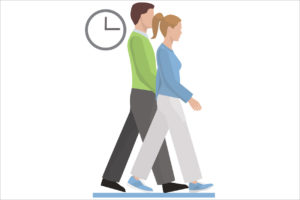March 11, 2020
Standing desks and other alternative workstations come with both risks and benefits
Reports of the hazards of a sedentary lifestyle seem to be everywhere, and some workers are refusing to take the news sitting down.
Now that the traditional “desk and chair” workstation has been cast as the office villain, a variety of alternatives have emerged. In some workplaces, traditional seated workstations are giving way to configurations in which the user stands or moves while working. Standing desks or sit/stand workstations are becoming an increasingly common option, and some have taken it even further by combining desks with exercise devices like treadmills or balance balls.
As employers consider adopting these devices, questions about safety are emerging.
Is the employer liable if someone gets hurt while using an alternative workstation?
If a worker becomes injured while using an exercise device, the question of liability traditionally hinges on the notion of “voluntary use.” If an exercise device is sponsored by the employer as part of a voluntary recreational program, then liability for an injury that occurs while using it would typically rest with the worker. The liability can shift to the employer in cases where the alternative workstation is a job requirement or is put in place as part of an approved medical treatment plan for the employee.
In general, the best approach is to leave the decision to use an alternative workstation to the discretion of the employee. For a definitive recommendation regarding any issues of liability, it’s always best to consult an attorney who specializes in employment law in your state.
Are alternative workstations such as standing desks safe?
When used correctly, these devices can certainly be a component of a safe workplace. It’s important to make sure the equipment is installed properly so it doesn’t place the user in a position that could lead to injury or stress. As with traditional desks and chairs, any new workstations should undergo an on-site ergonomic evaluation and be monitored for continued safety.
The key to counteracting the perils of working in the same position all day is to build frequent variety of movement into the daily routine.
In addition to recommending general ergonomic precautions, safety experts have identified some specific risks:
- Standing workstations: Standing is more tiring than sitting, and standing all day comes with its own health risks. Prolonged standing places a greater strain on the circulatory system, as well as on the legs and feet.
- Treadmill desks: Proper positioning of the treadmill is an important consideration. An improperly placed device can launch a worker who stops walking into a wall or other impediment.
- Balance balls: While a certain amount of instability is inherent to a balance ball, too much instability presents a risk of falling. Factors to consider are whether the ball is inflated properly, and whether the device is surrounded by a frame.
Are they effective?
Standing desks and alternative workstations can definitely be helpful if used as part of an overall campaign to encourage workers to move. The key to counteracting the perils of working in the same position all day is to build frequent variety of movement into the daily routine.
Alternative workstations can help, but they shouldn’t be viewed as the sole remedy. Without continued encouragement from the employer to stay active, workers often fall back into their low-motion routines. By itself, no device constitutes a simple way to reverse the negative effects of sitting still at a desk all day. Building movement into the day should be the goal.





